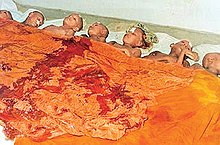The massacre
The Aranthalawa Massacre took place on June 2, 1987, [1] when a bus carrying Buddhist monks, most of whom were child monks, and a few unarmed civilians was approached by 20 [2] armed LTTE cadres near the village of Nuwaragalatenna, [3] [4] led by an LTTE leader named Reagan. [5] The driver let them in, mistaking them for Sri Lankan security force members. They then ordered the driver of the bus, which was carrying the monks on a pilgrimage from their temple in Mahavapi to the Kelaniya Raja Maha Vihara, [2] to drive into the nearby Aranthalawa jungle to a site where other LTTE members were waiting for them. After the bus stopped at the site, an LTTE cadre entered the bus ordered them to surrender any money and valuables, and the passengers complied. After this, they shot the driver dead. The chief priest of the Vidyananda Maha Pirivena, Hegoda Sri Indrasara Thera, permitted the cadres to kill him but asked them to spare the novices. He was then hacked to death. In a last-ditch effort, the children begged the cadres not to kill them; however, the cadres went on a rampage, attacking the young monks with guns and swords. [6] [7]
Among the dead were 30 young novice monks between the ages of 7 and 18. [6] Four civilians who were traveling in the bus were also among the dead. [8]
Three monks who survived the massacre, sustaining critical injuries, continue to require medical assistance. Another monk was permanently disabled. [9]
Reactions
Theravada monks are incapable of defending themselves. The harming of monk is considered to be one of the highest offenses in Theravada Buddhism or even among Hindu. The massacre is considered to be one of the most brutal LTTE attacks carried out during the conflict in Sri Lanka. [11]
Each year Aranthalawa Massacre is commemorated by a series of special programs. [12] In 2007, to coincide with the 20th anniversary of the massacre, commemorations were held over the course of four days in Colombo and Ampara, with the main ceremony led by Sri Lanka President Mahinda Rajapaksa taking place in Colombo with the participation of the Mahanayake Theras of all Chapters. An all night Pirith ceremony was held on the same night, and a Sanghika Dāna was offered to 200 Buddhist monks on June 3. An exhibition of over 300 photographs of LTTE attacks on Buddhist sites and other acts of destruction was also organized. [9]
A plaque has since been constructed close to the site of the incident to commemorate the massacre. [8]
This page is based on this
Wikipedia article Text is available under the
CC BY-SA 4.0 license; additional terms may apply.
Images, videos and audio are available under their respective licenses.
